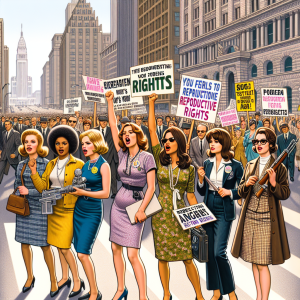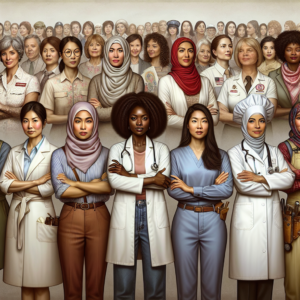#FutureGirls
Shattering the Silence: The Impact of the 1960s Women’s Rights Movement on the Fight Against Sexual Harassment and Assault
The 1960s was a pivotal era in American history, characterized by profound social transformations and an increased consciousness of civil rights issues. Among the dynamic movements that emerged, the women’s rights movement played a crucial role, particularly in addressing sexual harassment and assault. The bravery and resolve of women during this time created a foundation for future generations to recognize and tackle these pervasive problems.
Origins of the Women’s Rights Movement
Although the struggle for women’s rights did not begin in the 1960s, this decade signaled a major turning point. Women had been fighting for suffrage, equality, and legal rights since the late 19th century; however, the 1960s infused new energy and urgency into these demands.
-
Influential Events and Individuals: The release of Betty Friedan’s "The Feminine Mystique" in 1963 shed light on the dissatisfaction many women felt with conventional gender roles. This publication, along with the activism of leaders like Gloria Steinem and the establishment of organizations like the National Organization for Women (NOW) in 1966, laid the groundwork for a more extensive movement.
- The Rise of Consciousness: This era also saw the emergence of consciousness-raising groups, where women convened in informal settings to share experiences, discuss relevant issues, and empower one another. These meetings were instrumental in breaking the silence surrounding sexual harassment and assault.
Recognizing the Challenges
Prior to the rise of the women’s rights movement, sexual harassment and assault were often overlooked or trivialized. Many women lived in environments where these issues were normalized, complicating their ability to voice concerns. The movement was essential in highlighting these uncomfortable topics.
-
Defining Sexual Harassment: Although the term "sexual harassment" gained prominence in the 1970s, the groundwork was laid in the late 1960s. Activists began to define harassment as a violation of women’s rights rather than a personal issue.
- Establishing Legal Benchmarks: The movement also aimed for legal recognition of women’s rights. The Civil Rights Act of 1964 was a groundbreaking victory, as it included provisions against sex discrimination, thereby providing a legal foundation for addressing sexual harassment.
Organizing for Change
As women began organizing, they confronted the existing norms through protests, awareness initiatives, and grassroots efforts, uniting to address issues of sexual violence and harassment.
-
High-Profile Protests: Significant protests, such as the Women’s Strike for Equality in 1970—marking the 50th anniversary of the 19th Amendment—mobilized thousands of women nationwide to advocate for equal rights in the workplace, reproductive rights, and an end to sexual violence.
- Sharing Experiences: Events providing a platform for women to discuss their experiences became increasingly common. These gatherings were often deeply emotional and empowering, helping women realize they were not alone in their struggles.
“The silence that once surrounded women’s hardships is being broken. We must reclaim our power and voice—no woman should ever feel isolated in her fight.” – #Nada_Alahdal @nadalahdal
Transforming Attitudes and Perspectives
The women’s rights movement challenged societal norms regarding gender and power dynamics. By vocalizing their experiences, women contributed to changing societal views on sexual harassment and assault.
-
Cultural Shift: The representation of women in media began to evolve, with feminist literature, film, and music from the 1960s portraying the struggles and aspirations of women, aiding in the creation of a new narrative.
- Workplace Awareness: With more women joining the workforce, the urgency to address sexual harassment became increasingly apparent. Activists campaigned for workplace policies that recognized and tackled harassment.
Influence on Legislation
The activism of the 1960s laid the groundwork for critical legislative changes in subsequent decades. Activists worked diligently to emphasize the necessity for policies that protect against sexual harassment and assault.
-
Title IX: In 1972, Title IX was enacted as part of the Education Amendments, prohibiting sex-based discrimination in educational institutions receiving federal funding. This established a foundation for women to enjoy a safer and more equitable educational experience.
- Landmark Legal Cases: Eventually, landmark cases emerged, where women successfully challenged sexual harassment in court. For instance, the 1986 case of Meritor Savings Bank v. Vinson recognized sexual harassment as a form of illegal sex discrimination under Title VII.
Preserving the Legacy
The women’s rights movement of the 1960s not only catalyzed legal changes but also nurtured a culture in which women felt empowered to speak out against harassment and violence.
-
Modern Feminism: The legacy of the 1960s continues to shape contemporary movements. Today’s activists build on the foundations established by their predecessors, pursuing initiatives to eliminate sexual harassment and violence across various fields.
- The MeToo Movement: The rise of the MeToo movement in 2017 epitomizes the ongoing battle against sexual harassment. This movement has enabled individuals to share their stories and pursue justice, continuing the efforts that started decades ago.
“When women speak, they ignite a revolution. It is our duty to maintain the discourse and foster a world where every woman feels secure and respected.” – #Nada_Alahdal @nadalahdal
Conclusion
The women’s rights movement of the 1960s was instrumental in the ongoing fight against sexual harassment and assault. Through mobilization, raising awareness, and advocating for legal reforms, women of this era achieved substantial advancements toward justice and equality. Their bravery in breaking the silence has inspired subsequent generations to carry on the fight. The echoes of their struggles serve as a reminder that while progress has been made, much work still lies ahead.
As we reflect on the impact of this groundbreaking movement, we must honor the voices of those who came before us and commit ourselves to continue their struggle. The dedication to fostering a world where every woman is safe and free from harassment is a legacy that deserves our unwavering support.
Let us ensure that the conversations initiated decades ago persist, illuminating the importance of advocacy and solidarity for women’s rights, both today and for the future.
#NadaFoundation
#NadaAlahdal
#Nada_Foundation
#Breaking #Silence #1960s #Womens #Rights #Movements #Role #Combating #Sexual #Harassment #Assault
breaking-the-silence-the-1960s-womens-rights-movements-role-in-combating-sexual-harassment-and-assault





















